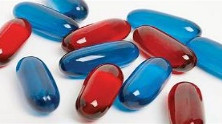Comparative Study of the Influence of Sodium Alginate and Hydroxypropyl Methylcellulose on the Release Profile of Ibuprofen from Subcutaneous Implant Formulations
http://www.doi.org/10.26538/tjnpr/v6i11.20
Keywords:
Sodium alginate, Implants, Ibuprofen, Hydroxypropyl methylcelluloseAbstract
Pharmaceutical implants are small sterile solid dosage forms consisting of a highly potent drug intended to be subcutaneously implanted under the skin by suitable special injector or surgical incision in order to deliver the active ingredient continuously over an extended period of time. The aim of this study was to compare the influence of sodium alginate and hydroxypropyl methylcellulose (HPMC) on the release profile of ibuprofen from subcutaneous implant formulations. The ibuprofen implants were formulated using the solvent casting technique with either sodium alginate or hydroxypropyl methylcellulose as the synthetic polymer. The formulated ibuprofen implants were then cut into appropriate sizes and their physicochemical properties such as thickness/diameter, moisture content, weight uniformity, drug content, swelling index, moisture sorption, drug-excipient interactions as well as in vitro drug release
were evaluated. The ibuprofen implants formulated using either sodium alginate or HPMC had uniform physical characteristics with minimum batch-to-batch variation. The mean diameter/thickness of the implants formulated using either sodium alginate or HPMC ranged from 2.45±0.01 – 2.98±0.01 mm and 2.87±0.01 - 3.01±0.01 mm respectively. The mean percentage drug content values for the ibuprofen subcutaneous implants ranged from 95.68±0.11-98.18±0.12%. The implants had moisture content values ranging from 27.64±0.01– 28.92±0.01%. The implants formulated using HPMC were found to have sustained the rate of drug release from the formulation better than those formulated using sodium alginate. There was a significant difference between the release rates of ibuprofen from implants formulated using HPMC and sodium alginate (P<0.05).
References
Ovenseri AC, Isesele JE, Obarisiagbon AJ, Halilu ME, Uhumwangho MU. Influence of carnauba wax on the release profile of ibuprofen implants. EMUJPharmSci 2022; 5(1):45-56.
Purushotham RK, Jaybhaye SI, Ravindra K, Bhandari A, Pratima S. Designing of Diclofenac Sodium Biodegradable Drug Implant for Speedy Fracture Healing. J Chem Pharm Res. 2010; 3(1): 330-337.
Isesele JE, Airemwen CO, Uchendu AP, Asemwota IO, Obarisiagbon AJ, Uhumwangho MU. Formulation and in vivo studies of ibuprofen biodegradable implants, Eur J Pharm and Med Res. 2021; 8(7): 58-65.
Stewart SA, Domínguez-Robles J, Donnelly RF, Larrañeta E. Implantable polymeric drug delivery devices: classification, manufacture, materials, and clinical applications. Polymers. 2018; 10(12): 1379-1385.
Gisele R, Da Silva L, Sílvia LF, Rubens CS, Rodrigo J, Armando-da-Silva CJ. Implants as drug delivery devices for the treatment of eye diseases. Braz J Pharm Sci. 2010; 46(3): 585- 595.
Airemwen CO, Isesele JE, Obarisiagbon AJ, Uhumwangho MU.Formulation of subcutaneous implantable drug delivery system of ibuprofen using biodegradable polymer. Nig J Pharm and App Sci Res. 2021; 10 (4): 14-21.
Aj MZ, Patil SK, Baviskar DT, Jain DK. Implantable drug delivery system: a review. Int. J. Pharm. Tech. Res. 2012; 4 (5): 280-292.
Kanzaria R, Kapadia Y, Lalji B, Desai TR. Implant-controlled release medicated formulation. Int J Pharm and Chem Sci. 2012; 1(1):59- 66.
Kleiner LW, Wright JC, Wang Y. Evolution of implantable and insertable drug delivery systems. J. Con Rel. 2014; 181(2)104- 115.
Cole ET, Scott RA, Connor AL, Wilding IR , Petereit HU , Schminke C, Beckert T, Cade D. Enteric coated HPMC capsules designed to achieve intestinal targeting, Int J Pharm. 2002; 231 (2): 83–95.
Jain A, Gupta Y, Jain SK. Perspectives of biodegradable natural polysaccharides for site specific drug delivery to the colon. J Pharm and Pharm Sci. 2007; 10: 86-128.
Fu Y, Kao WJ (2010). Drug release kinetics and transport mechanisms of non-degradable and degradable polymeric delivery systems. Exp opinion on drug del. 2010; 7(4): 429-444.
Korsemeyer RW, Gurny R, Doelker EM, Buri P, Peppas NA. Mechanism of solute release from porous hydrophilic polymers. Int J Pharm. 1983; 15: 25-35.
Fumimoto Y, Matsuyama A, Komoda H, Okura H, Lee CM, Nagao A. Creation of a rich subcutaneous vascular network with implanted adipose tissue derived stromal cells and adipose tissue enhances subcutaneous grafting of islets in diabetic mice. Tissue Eng. Meth, 2009; 15: 437-444.
British Pharmacopoeia. London, UK: Her Majesty’s Stationery Office. 2012; A234.
Higuchi T. Mechanism of sustained action medication. Theoretical analysis of rate release of solid drugs dispersed in solid matrices. J. Pharm. Sci, 1963; 52: 1145-1149.
Mohammed MI, Sanjeev E, Shanti S. Design and evaluation of subcutaneous implantable drug delivery system of tramadol using natural biodegradable polymer. Annals Phytomed, 2012; 2:30-38.
Negrin, CM, Delgado A, Llabres M, Evora C. Methadone implants for methadone maintenance treatment, in vitro and in vivo animal studies. J Con Release. 2004; 95: 413-421.
Oalta R, Grewal Y, Batth S, Singh A. A Survey of analgesic and anti-inflammatory drug prescription for oral implant surgery. Int J Plastic and Aesthetic Res. 2015; 2: 51-55.
Onishi HM, Takahashi N and Machinda Y. PLGA implant tablet of ketoprofen: comparison of in vitro and in vivo releases. Biol Pharm Bull. 2005; 28(10): 2011-2015.
Phattanaphakdee W, Ditipaeng C, Uttayarat P, Thongnopkoon T, Athikomkulchai S, Chittasupho C. Development and validation of HPLC method for determination of quercetin in hydrogel transdermal patches loaded with red onion peel extract. Trop J Nat Prod Res, 2022; 6(8):1210-1214.

Published
How to Cite
Issue
Section
License

This work is licensed under a Creative Commons Attribution-NonCommercial-NoDerivatives 4.0 International License.

















